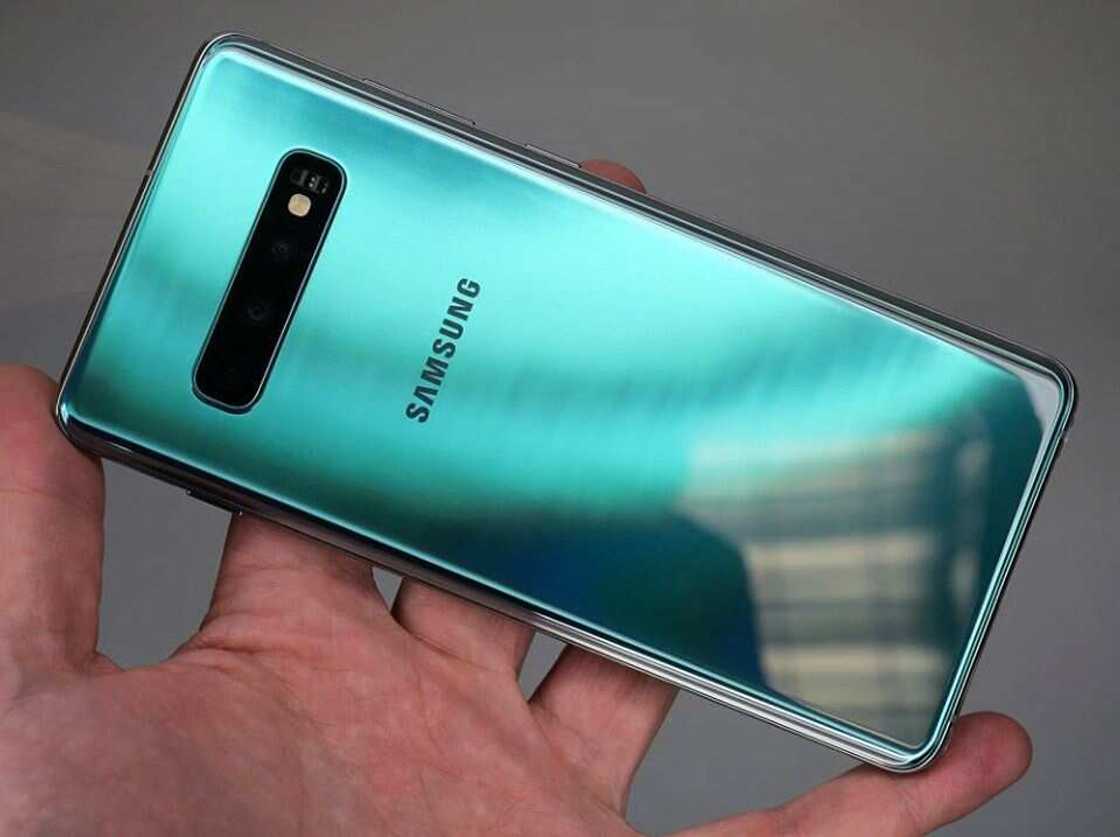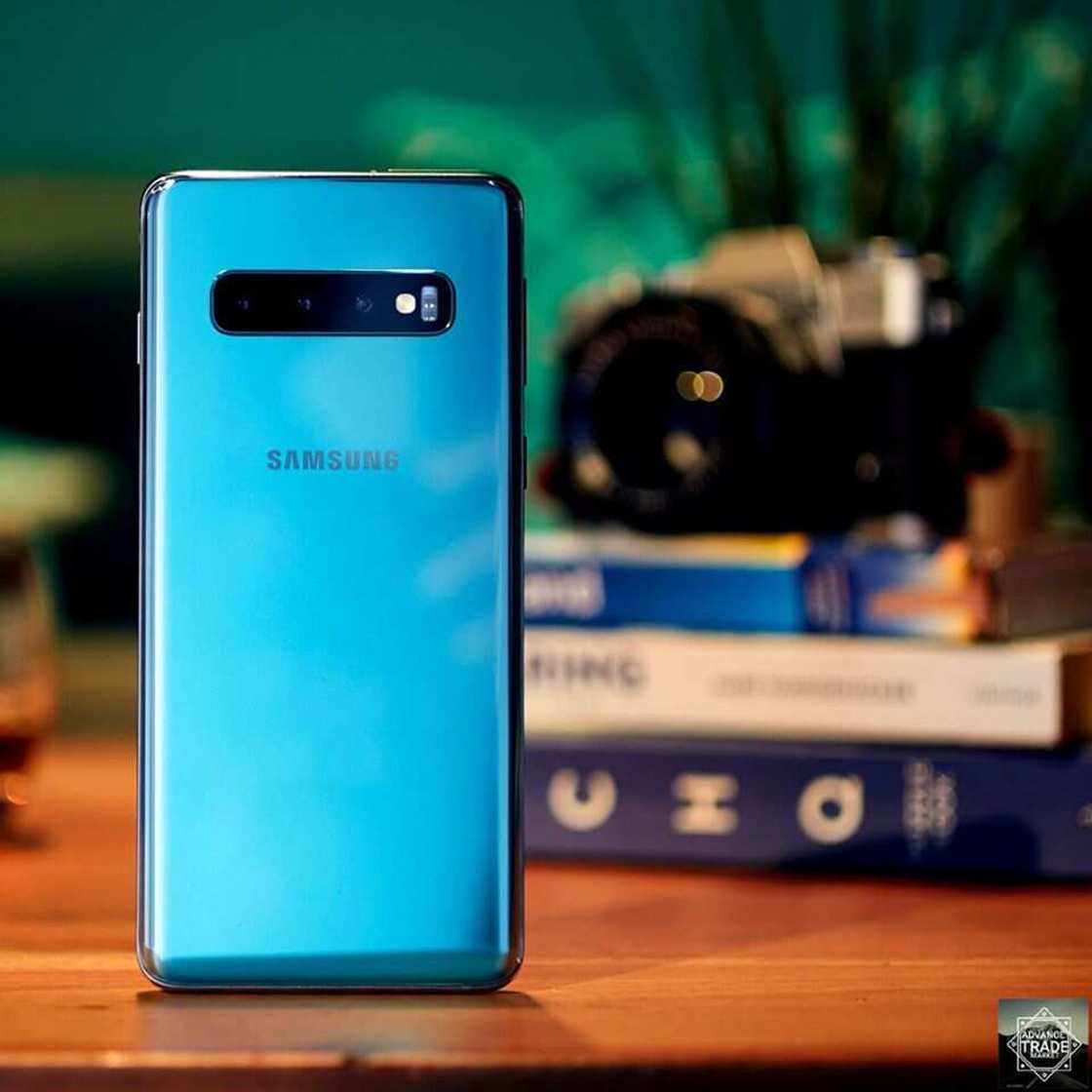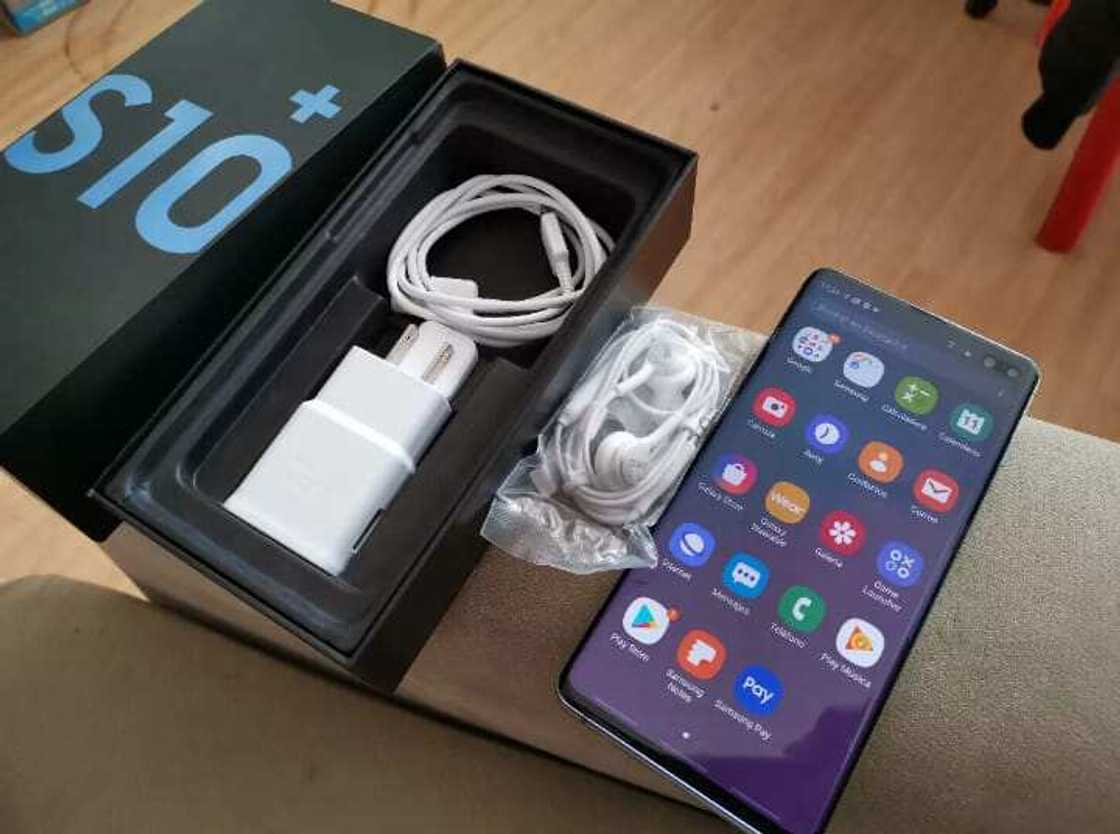Samsung S10 Plus price, specs, review
The Samsung S10 Plus has some striking resemblance to its predecessor, the Samsung Galaxy S9 Plus. However, there are still significant differences that set the new device apart. The most obvious is the punch-hole on the top right corner of the display that houses the dual selfie cameras. The fantastic AMOLED display covers almost the entirety of the front side, and a triple-camera module now occupies the rear.

Source: UGC
The Samsung S10 Plus price in Nigeria currently starts at ₦ 252,000 on Jumia, which is quite a premium. With a new powerful chipset, an enhanced RAM, and class-leading storage options, it is quite easy to justify the relatively high Samsung Galaxy S10 Plus price. The Samsung S10 Plus release date was in March 2019. Does the device meet its target market expectations?
Overview
Here is a look at the pros and cons of the device;
The good
- Excellent design, solid build, and a wide range of unique colors
- Incredible display with fantastic clarity, contracts, and colors
- Remarkable battery life
- Superb video and image quality
The bad
- Low-light selfie images are not as good as those from the primary camera
- The ultra-wide camera lacks autofocusing capabilities
- A bit pricey as compared to some other flagships
Samsung Galaxy S10 Plus specs
Here is a look at the top Samsung S10 Plus specs;
- Release date: March 2019
- Dimensions: 157.6 x 74.1 x 7.8 mm (length, width and thickness)
- Weight: 175 grams
- SIM card: Hybrid Dual Nano-SIM or single Nano-SIM
- Display: Dynamic AMOLED capacitive touchscreen
- Size: 6.4 inches
- Resolution: 1440 x 3040 pixels
- Operating system: Android 9.0 (Pie)
- Internal memory: 128GB ROM & 8GB RAM or 512GB ROM & 8GB RAM or 1TB ROM & 12GB RAM
- Expandable memory: MicroSD up to 1TB
- Camera: 12MP wide camera, 12MP telephoto camera & 16MP ultra-wide camera
- Selfie camera: 10MP and 8MP wide cameras
- USB: 3.1 with USB-C reversible connector
- Bluetooth: Version 5.0 with aptX, A2DP, and LE
- Sensors: Under-display fingerprint sensor, compass, heart rate, gyro sensor, and accelerometer
- Battery: 4100 mAh non-removable Li-Ion battery
- Charging: 15W fast charging
- Colors: Canary Yellow, Prism Black, Prism Blue, Flamingo Pink, Ceramic White, Smoke Blue, Cardinal Red, Prism White, Ceramic Black, Prism Green

Source: UGC
Hardware
Here is a look at the device’s hardware features;
Design
The most noticeable design element in the device is arguably the punch-hole on the top right corner. Some people consider this design less intrusive as compared to iPhone-style notches or the more common dewdrop notches from numerous manufacturers.
A fantastic Dynamic AMOLED panel occupies most of the front and is probably as close as mobile devices have gotten to an infinity display. The device still has some thin bezels on all sides, but still looks impressive. The proximity and ambient light sensors are housed underneath the screen. Unfortunately, there is no notification LED in this device.
The phone makes use of an under-display fingerprint sensor, which works great despite not being the fastest in the industry. On the back, a rectangular module houses three cameras, a heart rate sensor, and an LED flash. The lack of a rear-mounted fingerprint sensor undoubtedly contributes to a neater-looking backside.
Buyers can choose from a wide range of Samsung Galaxy S10 Plus colors. These include; Canary Yellow, Prism Black, Prism Blue, Flamingo Pink, Ceramic White, Smoke Blue, Cardinal Red, Prism White, Ceramic Black, and Prism Green. Besides the numerous Samsung S10 Plus colors, one can also choose from two available material options. The most common will be a glass front, aluminum panel, and back glass design, but there is also a glass front and ceramic body design.
The left of the device houses the Bixby key and volume rocker. They are both adequately large and well-shaped. The top side houses the hybrid card tray, which can hold two SIM cards. It can also contain one SIM card and a memory card (on Dual-SIM models only). The bottom of the device houses a USB-C port alongside a 3.5mm audio jack and a speaker grille. The S10+ is IP68-certified for water and dust protection.
Overall, the device’s design is excellent, and its build feels quite durable. The ceramic versions provide a better grip during use as compared to the all-glass versions.
Display
The smartphone is equipped with the company’s latest Dynamic AMOLED panel. The most significant difference between this panel and the previous model is the inclusion of HDR10+ capabilities. The screen measures 6.4 inches and is of QHD+ resolution (1440 by 3040 pixels). This works out to a fantastic 526PPI pixel density.
On the Samsung Galaxy S10 Plus release date, the company introduced the Infinity-O display with the ‘O’ standing for the punch hole that houses the selfie camera. The screen is quite bright and, if left on auto, it achieves maximum brightness of 793 nits. When set to manual, the panel will max out at 385 nits. The maximum level at auto is among the highest available in modern-day devices.
Image colors and contrast look great as expected from an AMOLED panel. The S10+ also comes with an option to choose from different colour modes.

Source: UGC
Processor, performance, and storage
The device is powered by some of the best processors in the industry. Users will either get the Exynos 9820 chipset or Qualcomm’s Snapdragon 855, depending on their market. Whichever one you get, rest assured that the performance is top-notch. The Exynos version comes with eight cores; two clocked at 2.7 GHz, two at 1.9 GHz, and four at 2.4 GHz.
All models come equipped with 8GB RAM except the Performance Edition, which has 12GB RAM. Storage begins at 128GB for the base model all the up to 1TB for the Performance Edition. Users will almost certainly have no problems with storage, RAM or processing power in either the base or Performance Edition.
Battery capacity
A 4100mAh battery powers this smartphone. This is one of the company’s highest-capacity batteries in a flagship device to date. To put this into perspective, the phone’s main competitor from Apple only has a 3174 mAh battery. However, there is more to battery performance than just the capacity.
In a test that was conducted by GSM Arena, the device’s battery lasted almost twelve hours during continuous web browsing, fifteen hours of video playback, and twenty-four hours of 3G calls. The S10+ has a fantastic battery life. In the future, hopefully, the manufacturer will consider even better battery options for its high-end devices.
Once the battery drains fully, the included fast charger can recharge it from zero to a hundred percent in one hour and thirty-three minutes. The charger is rated at 9V/1.67A and will, therefore, output a maximum of 15W. A thirty-minute charge will take the battery from zero to forty-one percent, which is quite impressive.

Source: UGC
The device also supports wireless charging using Qi-based tech by the manufacturer. A new feature in the S10+ is it’s the capability to charge other devices wirelessly through what the company calls Wireless Powershare. This feature makes it possible to charge another smartphone wirelessly while charging the S10+ using a cable.
Speaker and call quality
The S10+ has a stereo speaker setup with the bottom-firing speaker acting as the main output. It is supplemented by the earpiece (which serves as the second speaker). When the phone is held in landscape orientation, each speaker handles the channel on its side. In portrait mode, each speaker handles the channel it was last assigned.
The device posted excellent loudness scores, which were better than its predecessor. Audio files are clear when using the speakers as well as through the wired headphones. Volume levels are also excellent even when using high-impedance headsets. The presence of the Dolby Atmos Sound system and AKG tuning features improve the audio to perfection. Calls sound clear and loud, thanks to the presence of an active noise cancellation feature.
Software
Here is a look at the phone’s software features;
Operating system and features
The S10+ comes preinstalled with Android 9.0 (Pie) overlaid with the manufacturer’s One UI. The custom cover evolved from the much-hated TouchWiz in earlier Samsung phones. One UI is characterized by colorful iconography, focus for single-handed use, and rounded buttons and menus.
Similar to several other smartphones by the same manufacturer, the S10+ has an always-on display. In this device, however, users have the option to customize how the display behaves. One can choose to have the display on when they tap the screen or choose to always have it on. In October 2019, Samsung released a beta version of the Android 10 update for the S10 line of smartphones, which includes the S10+, S10, S10 Lite, and S10e. The new update brings enhanced features, such as focus mode and an improved dark mode.

Source: UGC
Camera review, video, and image quality
Samsung was late to join the dual-camera race with the first device to feature this being the S9+. However, the company did not wait too long to join the triple-camera trend. The S10+ comes with a three-camera module at the back. There is a 12MP wide camera, 12MP telephoto camera, and a 16MP ultra-wide camera. On the front, the device features two selfie cameras, although one works as a depth of focus sensor.
Image quality from the cameras is excellent. The pictures have fantastic clarity, detail, contrast, and colors. The dynamic range is also at par with the best devices in the industry. The only downside is that the ultra-wide camera lacks autofocus, although this will barely be an issue for many users. In terms of videography, the S10+ can record 4K and Full HD videos at 30 or 60 frames per second.
There are also options to shoot HDR10+ footage and slow-motion videos at 960 frames per second. Keep in mind that the slow-motion footage can only be recorded at a resolution of 720p. Video quality is also excellent, although it is hard to notice any difference between footage shot in thirty frames per second and one shot in sixty.
Samsung Galaxy S10 Plus review
Here is a look at a few Samsung S10 Plus review comments from social media platforms;
Verdict
The S10+ is arguably one of the best all-round devices available today. Its relatively few flaws are not entirely deal-breakers. The fantastic display, battery life, and excellent camera quality make the device a worthy contender for the best flagship device currently. Potential buyers could also look at the iPhone XS Max, Huawei Mate 20 Pro, Sony Xperia 1, and LG V50 ThinQ. The Samsung S10 is also a good alternative because it has all the features of the S10+ minus the dual selfie camera, all for a lower price.
Choosing the perfect high-end device is never an easy task since different manufacturers now make some highly appealing devices. The Samsung S10 Plus stands out from the pack with a few unique features such as the Infinity-O display and the new One UI custom OS cover. It is undoubtedly among the best flagship devices right now.
Source: Legit.ng










